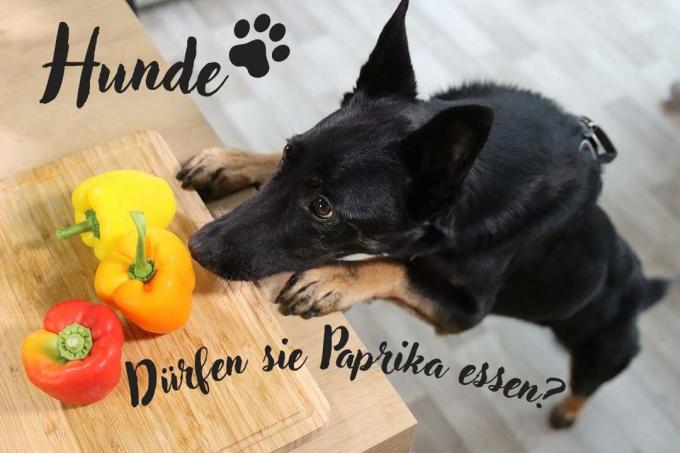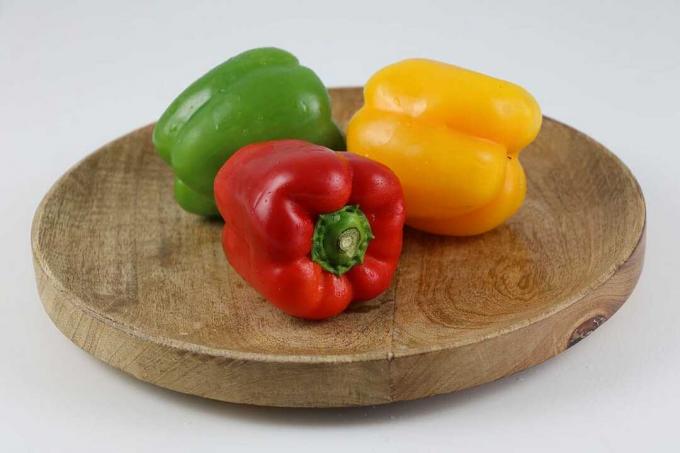
table of contents
- Poisonous solanine
- Compatible amounts
- Bell peppers cooked at best
- Prohibited: chilli and hot peppers
- Possible signs of intoxication
- First aid
- frequently asked Questions
As a carnivore, the dog should eat mainly meat. However, a healthy and balanced dog diet also includes various types of vegetables. Does it include paprika, which is rich in vitamins and minerals?
In a nutshell
- Bell peppers contain slightly toxic solanine
- causes vomiting, diarrhea, and digestive tract problems
- fully ripe red peppers only low solanine content
- Cooked peppers are also well tolerated
- However, do not feed green and yellow peppers
Poisonous solanine
Like potatoes, tomatoes and aubergines, sweet peppers are also part of the nightshade family. Characteristic of these plants is the content of solanine, a poisonous chemical compound. This is supposed to keep predators from eating the plants. Thus, the solanine is a natural pesticide.
- generally contain more solanine in unripe and ripening fruits
- therefore only feed dogs with strong red peppers
- comparatively high sugar content in sweet, ripe peppers
- also contain little solanine
- but high content of vitamin C as well as A and B, as well as potassium, magnesium and zinc
On the other hand, your dog should not eat yellow or even green peppers raw - these are immature and have a significantly higher solanine content.

Note: The peppers available in the supermarket are only ripe when they are red. For home and hobby gardeners, however, there are also Paprika varietiesthat ripen in yellow ('Goldflame'), orange or even purple ('Mavras'). The rule that only red peppers are fed does not apply to them, of course.
Compatible amounts
If your dog can tolerate it - after all, there are many sensitive animals that are sensitive to some foods such as peppers - you can give him raw peppers as follows:
- Thoroughly cut out the stalk, white parts and seeds
- Wash the peppers under hot running water
- Use organic quality if possible (avoid pesticides)
- Do not feed stalk, contains a lot of solanine
- Before feeding, cut into bite-sized pieces or strips
- give a maximum of a few narrow strips
Tip: Give your four-legged friend fully ripe red peppers no more than once a week and prefer otherwise unproblematic, but no less healthy vegetables.
Bell peppers cooked at best
You are absolutely on the safe side if you only give your darling the peppers cooked. Raw vegetables contain more solanine, while the toxin dissolves during cooking and passes into the cooking water. That's why you should cook nightshade plants - even potatoes! - Always throw away the cooking water and never use it for pureeing or making sauces.
Note: Please note, however, that cooking the peppers makes them easier to digest - but also destroys valuable vitamins such as the heat-sensitive vitamin C.
Prohibited: chilli and hot peppers
The hot paprika varieties that are so popular with humans, such as chilli or hot peppers, are absolutely forbidden for dogs. The substance capsaicin contained in these fruits and responsible for the spiciness has a strong effect irritating to skin and mucous membranes, it can cause severe pain and is harmful to health Problems like
- Circulatory problems and dizziness
- Vomiting and diarrhea
- Irritation of the gastric mucosa
- as well as inflammation
to lead.

Tip: In general, strongly or spicy dishes are not suitable for dogs, which includes spicy vegetables as well as spices such as pepper, curry or nutmeg.
Possible signs of intoxication
Basically, poisoning by paprika - regardless of whether it is raw or cooked - is only very common in dogs sensitive gastrointestinal tract, in small dogs (depending on the amount eaten) or in large amounts eaten possible. Possible signs of intoxication can include:
- Vomit
- diarrhea
- Circulatory problems, dizziness
- heavy sweating
- Breathing problems
- fever
If you suspect poisoning, you should look at the mucous membranes on the lips. In healthy animals these are pink - a typical sign of poisoning, on the other hand, is a pale to white color.
First aid
If you suspect poisoning from (too much) eaten peppers, you have three options:
- Wait and watch the dog for possible symptoms of poisoning.
- Go to the vet within the first hour after eating and inject the animal with vomiting medication. However, the vet will examine the dog beforehand and determine whether this measure is actually necessary or not.
- Give activated charcoal, which binds the toxins in the body. However, you should have spoken to your veterinarian beforehand about the correct dosage in the event of poisoning.
Basically, it always makes sense to go to the vet once too often rather than once too little.
frequently asked Questions
Some dogs love peppers and eat large amounts of them, so their owners are amazed at our advice. Like us humans, dogs are very different and have a differently sensitive digestive system. Some animals can tolerate a lot of paprika very well, while others show discomfort after just a little bit. That is individually different. However, even the seemingly unproblematic eaters can suffer long-term damage after long-term large quantities. Solanine, for example, is suspected of causing cancer in dogs.
You can feed your dog raw carrots, celery, cucumber or salads, cooked potatoes, broccoli, pumpkin or zucchini are also good. Make sure to chop hard vegetables well, such as grating or pureeing. So your dog cannot choke while eating. The vegetables should also not be seasoned, especially not with salt, hot spices, onions or garlic. Many types of fruit such as apples, pears, cherries and plums (without seeds!) And all kinds of edible berries are also suitable.
Under no circumstances should you feed your dog these poisonous vegetables: raw or green potatoes, tomatoes, raw onions, as well as garlic and avocado. In the worst case scenario, onions and garlic can destroy your dog's red blood cells, while tomatoes are harmful to the kidneys, nervous system and digestive tract. Dogs are not allowed to eat rhubarb or grapes on fruits, as these are kidney damaging.



